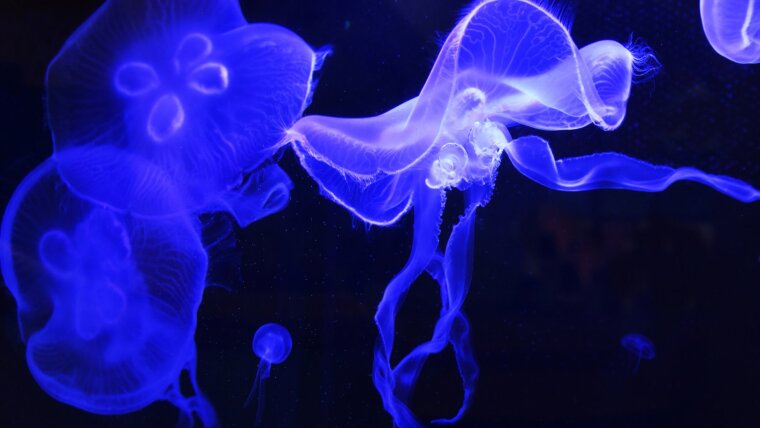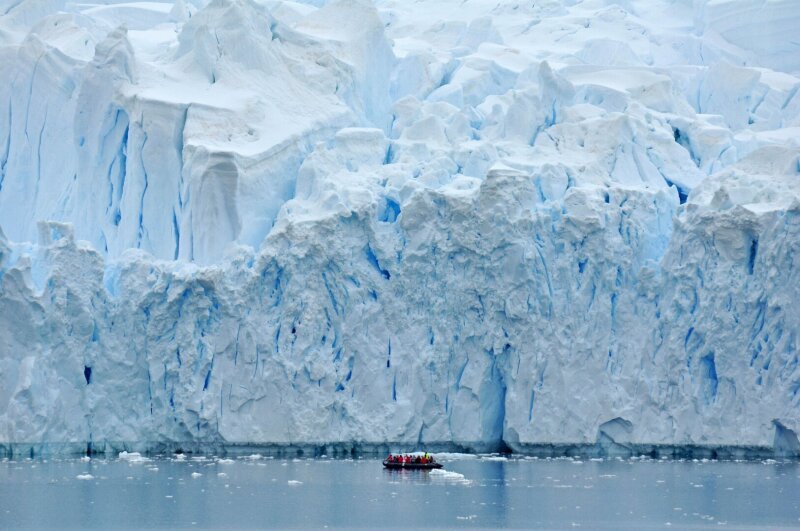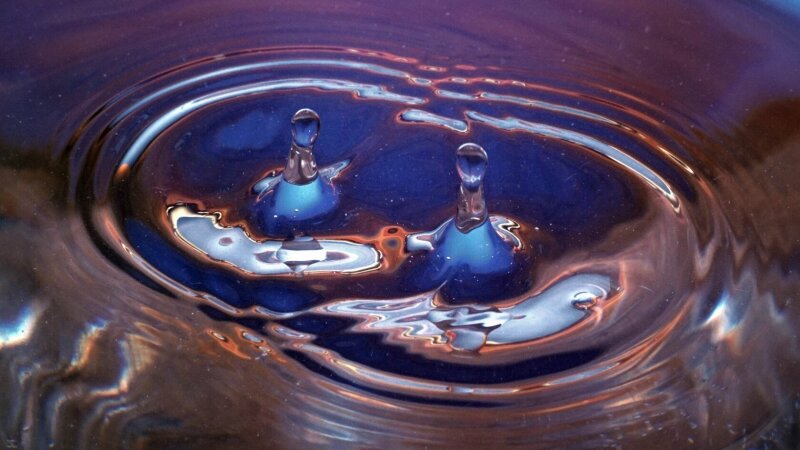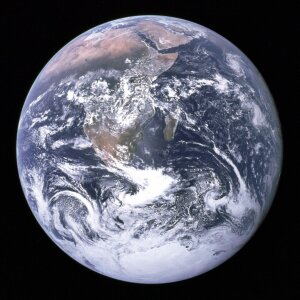
If we gaze at our planet from the depths of space, it shines like a deep blue globe. This is due to the sheer mass of water that covers most of its surface. Water is also found on other celestial bodies, in other planetary systems and galaxies, but here, on our »blue planet«, it occurs in large quantities in a liquid state. We owe our very existence to this cosmic circumstance. Life as we know it could not have evolved without liquid water. But where does the water on Earth actually come from and what makes this extraordinary chemical compound the »elixir of life«?
By Ute Schönfelder
If we want to trace the origins of water in the universe, we have to go right back to the beginning. In the first few seconds after the universe was born, hydrogen nuclei – the positively charged protons – condensed out of the matter that was being formed. This was immediately followed by the combination of protons, negatively charged electrons and neutral neutrons to form the elements helium, lithium and beryllium. All other, heavier elements needed the help of gravity; they could only be formed when gas clouds had formed and matter had been compressed and heated to create stars.
To this day, however, almost the entire mass of the universe consists of the gases hydrogen (around three quarters) and helium (around one quarter). The third most common element is oxygen. As helium is extremely inert, water is the chemical compound formed from the most common elements that can actually react with each other. So, it is not all that surprising that water is formed in the universe.
How did water end up on the Earth?
However, how it got to Earth has not been clarified to this day. The most credible hypothesis is that water was brought to us by impacts from asteroids, meteorites and comets from cold regions far from the sun, and initially accumulated as vapour in the atmosphere during the early stages of the Earth’s formation around four and a half billion years ago. Once the Earth had cooled sufficiently, the vapour clouds rained themselves out and the resulting oceans made the Earth what it is today: the blue planet. More than two-thirds of the planet’s surface is covered by water. And most of the land masses are also formed by water; rivers shift sediments, erode mountains and carve valleys into the land.
What forms of water are found on Earth?
The water that shapes our planet is constantly in motion. It is distributed between the Earth’s surface and the atmosphere, evaporating and condensing in a continuous cycle. It occurs on Earth in all three states of matter: ice, liquid and vapour. The smallest part – only about one thousandth of a percent – is found as vapour in the atmosphere, but it has an enormous influence there; water vapour causes precipitation and acts as a natural greenhouse gas, keeping temperature fluctuations on Earth low and forming cloudy shields that protect us from intense solar radiation.
Another small proportion of the Earth’s water – albeit slightly larger at 2% – is frozen. This »cryosphere« in the polar regions and glaciers was much larger during the past ice ages than it is today: As a result, the sea level was up to 200 metres deeper during the last ice age than it is today. The frozen water contains around three-quarters of the Earth’s entire freshwater resources. Most of this can be found in Antarctica, where it forms a sheet of ice that is several thousand metres thick and several hundred thousand years old.
A boat passes through Paradise Bay in West Antarctica. The sheet of ice at the Earth’s poles contains a large amount of the world’s freshwater supply. However, only about 2% of the water on Earth is frozen.
Image: Christina BraunThe chemical peculiarities of water
Despite the prevalence of water on Earth, it is an absolute exception from a chemical point of view. It behaves differently than expected with regard to many of its properties, especially in comparison to similar compounds. For example, this »anomaly« means that frozen water has a lower density than liquid water. This is reflected in the fact that ice floats on water and doesn’t sink. As a result of this characteristic, bodies of water freeze over at sub-zero temperatures first on the surface and not at the bottom. If water wasn’t such an anomaly, there would be no ice floes and we wouldn’t be able to skate on a frozen lake. Above all, however, marine life would be much different if fish, amphibians or plants were not able to thrive at the bottom of the water during the winter.
The water molecule H2O has a basic tetrahedral structure; it resembles a pyramid with four triangular bases and four corners. The oxygen atom is in the middle of the molecule, and the four corners are formed by two hydrogen atoms and two lone electron pairs from the oxygen atom. This charge distribution – positive at the hydrogen corners and negative at the electron corners – causes individual water molecules to be attracted to one another and align themselves accordingly. The resulting hydrogen bonds hold the molecules loosely together and prevent them from moving freely in a completely disordered manner. This can be observed, for example, as surface tension; up to a certain volume, water forms round droplets instead of simply flowing apart, and small insects can walk on water without sinking. The high melting and boiling point of water is also a result of this chemical peculiarity. By way of comparison, methane has a similar molecular size to water and also has a basic tetrahedral structure, but it boils at -162°C. This is because it does not form any hydrogen bonds.
In its solid state, water is perfectly arranged as an ice crystal. Each molecule is firmly connected to four neighbouring molecules, creating a regular network with a basic hexagonal pattern. This is the reason why ice crystals (e.g. snowflakes), as unique as they may be in their individual shape, always have exactly six points.
And last but not least, hydrogen bonds are also effective in other molecules, such as in the large biomolecules that make up life on Earth. This is why proteins remain folded in defined structures and DNA strands form the famous double helix – hydrogen bonds are fundamental components for the basic molecular processes in living cells.
Thanks to its hydrogen bonds – the way in which its molecules interact with one another – water has a high surface tension. This is reflected in the fact that water forms droplets.
Image: Jan-Peter Kasper (University of Jena)The source of life and human civilization
There is no living thing on Earth that can do without water. Not only is liquid water the foundation of all life processes in cells; it is also a reaction chamber, transport medium and means of transport for nutrients and metabolites. It was also the cradle of life itself; for the vast majority of time since its emergence on Earth more than three billion years ago, life has been found exclusively in water. To this day, water is by far the largest habitat on Earth, home to millions of species.
We humans cannot do without water either. It is our most important food – we can only survive for a few days without drinking water. We need it for washing, agriculture, industry, energy production, transport routes and much more. Early human civilizations settled along the great rivers: the Euphrates and Tigris, the Nile, the Indus and the Yangtze. And to this day, most of our cities have access to a river or sea.
This photograph of the Earth was taken in 1972 by the crew of NASA’s »Apollo 17« mission on their way to the moon. It is known around the world as the »Blue Marble«.
Image: NASAThe »Blue Marble«
Although water seems to shine in majestic blue from space, it is actually transparent and colourless. The fact that it appears blue is due to various effects. On the one hand, its molecules primarily absorb the long-wave (red) part of sunlight. When white light, which combines all colours of the light spectrum, hits water, more and more of the red part is filtered out as the light travels through the water. On the other hand, the remaining part of the light is scattered by particles suspended in the water and cast back to the surface. This makes water appear blue.


